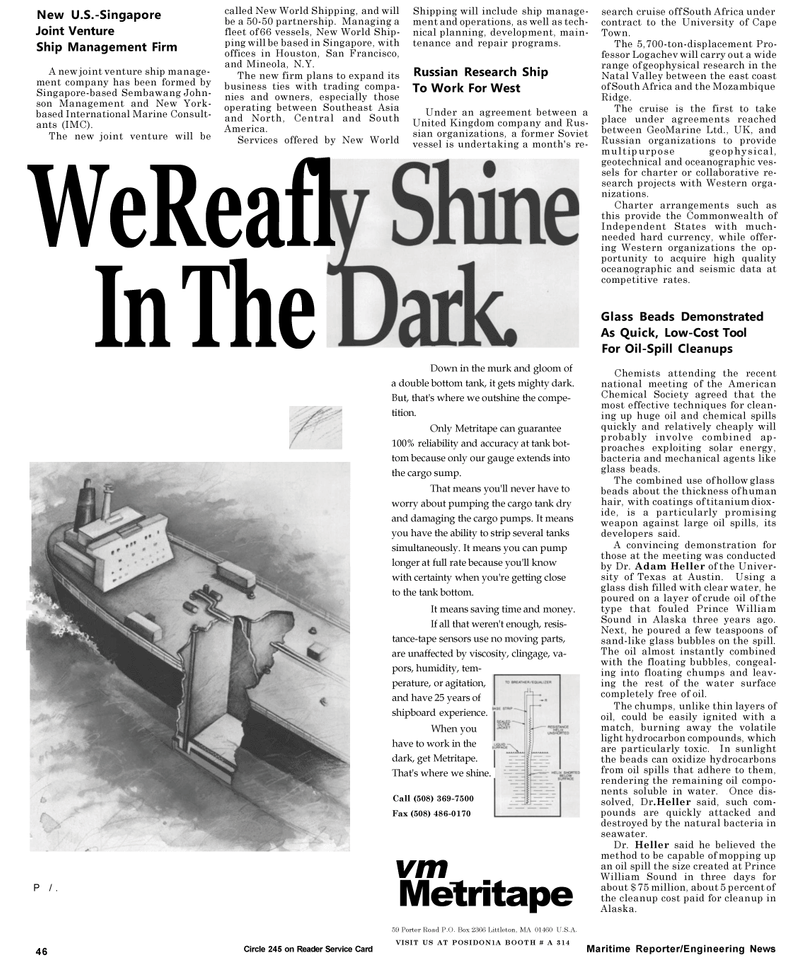
Page 48: of Maritime Reporter Magazine (May 1992)
Read this page in Pdf, Flash or Html5 edition of May 1992 Maritime Reporter Magazine
New U.S.-Singapore
Joint Venture
Ship Management Firm
A new joint venture ship manage- ment company has been formed by
Singapore-based Sembawang John- son Management and New York- based International Marine Consult- ants (IMC).
The new joint venture will be called New World Shipping, and will be a 50-50 partnership. Managing a fleet of 66 vessels, New World Ship- ping will be based in Singapore, with offices in Houston, San Francisco, and Mineola, N.Y.
The new firm plans to expand its business ties with trading compa- nies and owners, especially those operating between Southeast Asia and North, Central and South
America.
Services offered by New World
Shipping will include ship manage- ment and operations, as well as tech- nical planning, development, main- tenance and repair programs.
Russian Research Ship
To Work For West
Under an agreement between a
United Kingdom company and Rus- sian organizations, a former Soviet vessel is undertaking a month's re-WeReafl
In The
P /.
Down in the murk and gloom of a double bottom tank, it gets mighty dark.
But, that's where we outshine the compe- tition.
Only Metritape can guarantee 100% reliability and accuracy at tank bot- tom because only our gauge extends into the cargo sump.
That means you'll never have to worry about pumping the cargo tank dry and damaging the cargo pumps. It means you have the ability to strip several tanks simultaneously. It means you can pump longer at full rate because you'll know with certainty when you're getting close to the tank bottom.
It means saving time and money.
If all that weren't enough, resis- tance-tape sensors use no moving parts, are unaffected by viscosity, clingage, va- pors, humidity, tem- perature, or agitation, and have 25 years of shipboard experience.
When you have to work in the dark, get Metritape.
That's where we shine.
Call (508) 369-7500
Fax (508) 486-0170 vm Metritape search cruise off South Africa under contract to the University of Cape
Town.
The 5,700-ton-displacement Pro- fessor Logachev will carry out a wide range of geophysical research in the
Natal Valley between the east coast of South Africa and the Mozambique
Ridge.
The cruise is the first to take place under agreements reached between GeoMarine Ltd., UK, and
Russian organizations to provide multipurpose geophysical, geotechnical and oceanographic ves- sels for charter or collaborative re- search projects with Western orga- nizations.
Charter arrangements such as this provide the Commonwealth of
Independent States with much- needed hard currency, while offer- ing Western organizations the op- portunity to acquire high quality oceanographic and seismic data at competitive rates.
Glass Beads Demonstrated
As Quick, Low-Cost Tool
For Oil-Spill Cleanups
Chemists attending the recent national meeting of the American
Chemical Society agreed that the most effective techniques for clean- ing up huge oil and chemical spills quickly and relatively cheaply will probably involve combined ap- proaches exploiting solar energy, bacteria and mechanical agents like glass beads.
The combined use of hollow glass beads about the thickness of human hair, with coatings of titanium diox- ide, is a particularly promising weapon against large oil spills, its developers said.
A convincing demonstration for those at the meeting was conducted by Dr. Adam Heller of the Univer- sity of Texas at Austin. Using a glass dish filled with clear water, he poured on a layer of crude oil of the type that fouled Prince William
Sound in Alaska three years ago.
Next, he poured a few teaspoons of sand-like glass bubbles on the spill.
The oil almost instantly combined with the floating bubbles, congeal- ing into floating chumps and leav- ing the rest of the water surface completely free of oil.
The chumps, unlike thin layers of oil, could be easily ignited with a match, burning away the volatile light hydrocarbon compounds, which are particularly toxic. In sunlight the beads can oxidize hydrocarbons from oil spills that adhere to them, rendering the remaining oil compo- nents soluble in water. Once dis- solved, Dr.Heller said, such com- pounds are quickly attacked and destroyed by the natural bacteria in seawater.
Dr. Heller said he believed the method to be capable of mopping up an oil spill the size created at Prince
William Sound in three days for about $ 75 million, about 5 percent of the cleanup cost paid for cleanup in
Alaska. 46 Circle 245 on Reader Service Card 59 Porter Road P.O. Box 2366 Littleton, MA 01460 U.S.A.
VISIT US AT POSIDON1A BOOTH # A 314 Maritime Reporter/Engineering News

 47
47

 49
49
